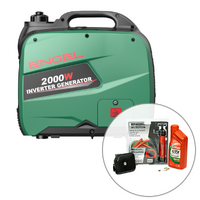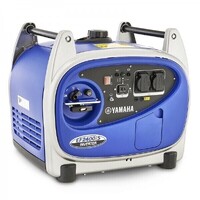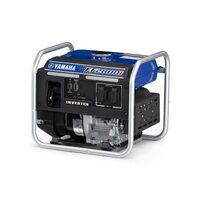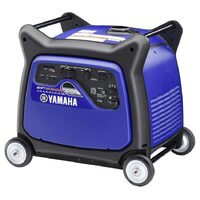Inverter Generators

Amps
Displacement (cc)
Voltage (v)
Cont. Running Time @100% Load
Cont. Running Time @50% Load
Parallel Capability
Wattage (W)
kVA
Maximum Output (Watts)
- 2000W
- 3500kVA (Max Power):3.5
- 3500W
- 3800W
- 4000W
- 7500
- 1000
- 2000
- 2100
- 2200
- 2300
- 2400
- 2500
- 2800
- 3000
- 3200
- 3300
- 3400
- 3500
- 4500
- 5500
- 6000
- 6300
- 7000
- 8000
- 9000
- 13000
Standby kVA
Brand
Product Category
Filter By Price Range
- $10,000 or below
- $10,000 to $20,000
- $20,000 to $30,000
- $30,000 to $40,000
- $40,000 to $50,000
- $50,000 to $60,000
- $60,000 or above
Price
Product Category
-
- Inverter Generators
- Fischer Panda Generators
Brand
-
- Yamaha
- Pramac
- MaxWatt
- Hyundai
- Fischer Panda
- Engel
- Cromtech
- Briggs and Stratton
- Aussie Traveller
Maximum Output (Watts)
-
- 13000
- 9000
- 8000
- 7000
- 6300
- 6000
- 5500
- 4500
- 3500
- 3400
- 3300
- 3200
- 3000
- 2800
- 2500
- 2400
- 2300
- 2200
- 2100
- 2000
- 1000
- 7500
- 4000W
- 3800W
- 3500W
- 3500kVA (Max Power):3.5
- 2000W
Standby kVA
-
- 15
- 10
- 8
- 5
kVA
-
- 15
- 10
- 9
- 8
- 7.5
- 7
- 6.3
- 6
- 5.5
- 5
- 4.5
- 3.5
- 3.2
- 3
- 2.8
- 2.5
- 2.4
- 2.2
- 2.1
- 2
- 1.9
- 1
Wattage (W)
-
- 9000
Parallel Capability
-
- Yes
Cont. Running Time @50% Load
-
- 9.8 hours
Cont. Running Time @100% Load
-
- 5.6 hours
Amps
-
- 35.4
- 34.2A
- 11.67A
Voltage (v)
-
- 240
Displacement (cc)
-
- 223
- 160
- 149
Filter By Brand
- Aussie Traveller (3)
- Briggs and Stratton (6)
- Cromtech (4)
- Engel (4)
- Fischer Panda (8)
- Hyundai (3)
- MaxWatt (11)
- Pramac (4)
- Yamaha (7)
Filter By Stock
Best Sellers
Inverter Generators
Amps
Displacement (cc)
Voltage (v)
Cont. Running Time @100% Load
Cont. Running Time @50% Load
Parallel Capability
Wattage (W)
kVA
Maximum Output (Watts)
- 2000W
- 3500kVA (Max Power):3.5
- 3500W
- 3800W
- 4000W
- 7500
- 1000
- 2000
- 2100
- 2200
- 2300
- 2400
- 2500
- 2800
- 3000
- 3200
- 3300
- 3400
- 3500
- 4500
- 5500
- 6000
- 6300
- 7000
- 8000
- 9000
- 13000
Standby kVA
Brand
Product Category
Price
Product Category
-
- Inverter Generators
- Fischer Panda Generators
Brand
-
- Yamaha
- Pramac
- MaxWatt
- Hyundai
- Fischer Panda
- Engel
- Cromtech
- Briggs and Stratton
- Aussie Traveller
Maximum Output (Watts)
-
- 13000
- 9000
- 8000
- 7000
- 6300
- 6000
- 5500
- 4500
- 3500
- 3400
- 3300
- 3200
- 3000
- 2800
- 2500
- 2400
- 2300
- 2200
- 2100
- 2000
- 1000
- 7500
- 4000W
- 3800W
- 3500W
- 3500kVA (Max Power):3.5
- 2000W
Standby kVA
-
- 15
- 10
- 8
- 5
kVA
-
- 15
- 10
- 9
- 8
- 7.5
- 7
- 6.3
- 6
- 5.5
- 5
- 4.5
- 3.5
- 3.2
- 3
- 2.8
- 2.5
- 2.4
- 2.2
- 2.1
- 2
- 1.9
- 1
Wattage (W)
-
- 9000
Parallel Capability
-
- Yes
Cont. Running Time @50% Load
-
- 9.8 hours
Cont. Running Time @100% Load
-
- 5.6 hours
Amps
-
- 35.4
- 34.2A
- 11.67A
Voltage (v)
-
- 240
Displacement (cc)
-
- 223
- 160
- 149
Filter By Brand
- Aussie Traveller (3)
- Briggs and Stratton (6)
- Cromtech (4)
- Engel (4)
- Fischer Panda (8)
- Hyundai (3)
- MaxWatt (11)
- Pramac (4)
- Yamaha (7)
Filter By Stock
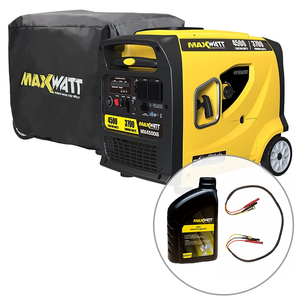
MaxWatt 4500W Petrol Inverter Generator with Electric Start, 2 Year Warranty
$1,699 RRP: $1,749 Save: $50
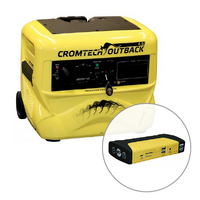
Cromtech 4500w Inverter Generator Electric Start, 1 Year Warranty
$2,129 RRP: $2,268 Save: $139

MaxWatt 8000W Petrol Inverter Generator with 2-wire Auto Start, 2 Year Warranty
$3,949 RRP: $3,999 Save: $50

MaxWatt 6000W Petrol Inverter Generator with 2-Wire Auto Start, 2 Year Warranty
$2,498 RRP: $2,599 Save: $101
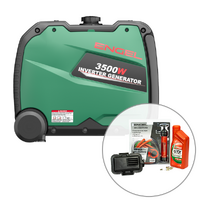
Engel R3000IE 3500W Pure Sinewave Inverter Generator, 4 Year Warranty
$1,699 RRP: $1,749 Save: $50

Cromtech Outback Platinum 2400W Inverter Generator, 2 Year Warranty
$899 RRP: $1,390 Save: $491
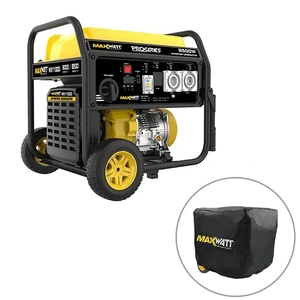
MaxWatt 9000W Petrol Inverter Generator with 2-Wire Auto Start, 2 Year Warranty
$2,599 RRP: $2,699 Save: $100

Pramac P2200i 2100w Inverter Generator, 3 Year Warranty
$752 RRP: $779 Save: $27
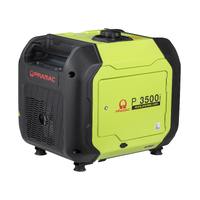
Pramac P3500i 3300w Inverter Generator, 3 Year Warranty
$1,257 RRP: $1,275 Save: $18

Hyundai HY3500i 3500w Inverter Generator, 1 Year Warranty/500 hour whichever occurs first
$1,560 RRP: $1,574 Save: $14
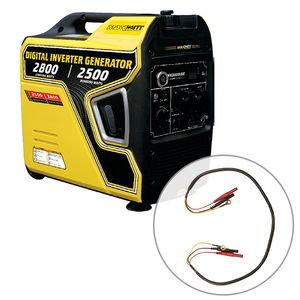
Maxwatt 2800W Petrol Inverter Generator with Electric Start, 2 Year Warranty
$1,279 RRP: $1,299 Save: $20
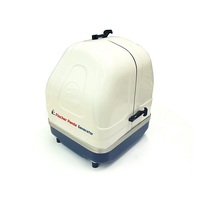
Fischer Panda 5kVA Diesel Marine Inverter Generator 5000i Neo, 1 Year Warranty
$22,999

Cromtech 7000w Inverter Generator, 1 Year Warranty
$4,499 RRP: $4,811 Save: $312

MaxWatt 13000W Petrol Inverter Generator with 2-Wire Auto Start, 2 Year Warranty
$8,499 RRP: $8,999 Save: $500

Hyundai HY8000i 8000w Inverter Generator, 1 Year Warranty/500 hour whichever occurs first
$4,793 RRP: $4,961 Save: $168

Aussie Traveller MC1000I 1000W Inverter Generator, 1 Year Warranty
$279 RRP: $700 Save: $421

Briggs & Stratton 2500w Inverter Generator, 3 Year Warranty
$1,396 RRP: $1,399 Save: $3
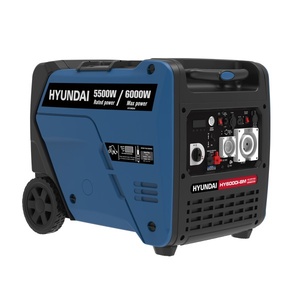
Hyundai HY6000i 7500w Inverter Generator, 1 Year Warranty
$2,614 RRP: $2,649 Save: $35

Cromtech 7000w Inverter Generator with Hire Pack, 1 Year Warranty
$4,999 RRP: $5,561 Save: $562
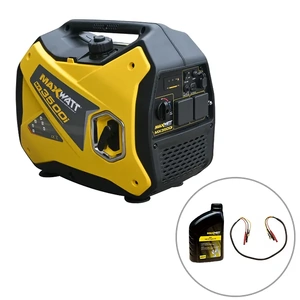
Maxwatt 3500W Silent Digital Inverter Generator, 2 Year Warranty
$999 RRP: $1,099 Save: $100
Best Sellers From This Category:

MaxWatt 4500W Petrol Inverter Generator with Electric Start, 2 Year Warranty
$1,699 RRP: $1,749 Save: $50

Cromtech 4500w Inverter Generator Electric Start, 1 Year Warranty
$2,129 RRP: $2,268 Save: $139

MaxWatt 8000W Petrol Inverter Generator with 2-wire Auto Start, 2 Year Warranty
$3,949 RRP: $3,999 Save: $50

MaxWatt 6000W Petrol Inverter Generator with 2-Wire Auto Start, 2 Year Warranty
$2,498 RRP: $2,599 Save: $101

Engel R3000IE 3500W Pure Sinewave Inverter Generator, 4 Year Warranty
$1,699 RRP: $1,749 Save: $50

Cromtech Outback Platinum 2400W Inverter Generator, 2 Year Warranty
$899 RRP: $1,390 Save: $491

MaxWatt 9000W Petrol Inverter Generator with 2-Wire Auto Start, 2 Year Warranty
$2,599 RRP: $2,699 Save: $100

Pramac P2200i 2100w Inverter Generator, 3 Year Warranty
$752 RRP: $779 Save: $27

Pramac P3500i 3300w Inverter Generator, 3 Year Warranty
$1,257 RRP: $1,275 Save: $18
Inverter Generators For Portable Power
At My Generator, we pride ourselves on being Australia’s premium online retailer for portable power products. Our extensive range of inverter generators is designed to meet the needs of every adventure, from recreational vehicles and caravans, to industrial applications.
Inverter generators are essential for caravan, 4WD, or RV owners, as well as those needing reliable back up power, or portable power for remote worksites. Whether you’re caravanning across Australia or powering essential appliances during a blackout, inverter generators ensure you have consistent and reliable power. They are quiet, fuel-efficient, and capable of running sensitive electronics such as laptops, phones, or GPS devices without risk of damage.
A Comprehensive Range Of Inverter Generators
Our category of inverter generators includes models to suit every requirement. If you need something compact and portable, we offer small inverter generators up to 2000W. These are perfect for light recreational use, ensuring you have power for essential devices. For those needing a little more power, our large inverter generators deliver 3001W and above for those who require high power output without compromising on portability. We stock leading brands such as Cromtech, Briggs & Stratton, Yamaha, Maxwatt, Hyundai, and more.
Features Of Inverter Generators At My Generator
The inverter generators available at My Generator come with a range of innovative features designed to provide convenience and reliability. Our models are built to go anywhere easily, making them perfect for camping, boating, and other outdoor adventures. With smart throttle technology, many can maximise fuel efficiency by adjusting the engine speed to the power load, ensuring you get the most out of your fuel. Additionally, these generators are safe for sensitive electronics, so you can run your laptops, tablets, caravan TVs, and even caravan air conditioners without worry. Maintenance is also a breeze, thanks to the easy-access ports on many models, which simplifies upkeep and ensures long-lasting performance.
Your One-Stop Shop For Portable Power At My Generator
When it comes to finding the right inverter generators, My Generator is your trusted one-stop shop. We offer a wide range of reliable power products designed to meet the needs of both recreational users and professionals. Explore our range of inverter generators online or reach out to our expert team on 1300 400 122 for assistance. Let us help you find the perfect power solution for your next adventure or project.
Inverter Generators FAQs:
-
1. My product manual for my inverter generator mentions an 'earthing wire / earthing stake' - do I need this?
This is mentioned in generator manuals and is a safety feature that will earth the generator. An earth wire and stake are not supplied with generators that we sell and are application specific. In practice, we do not see customer's do this, especially for inverter generators. It can be something that is implemented for more specialised generators on mining work sites for example. It is not common practice to 'earth' the generator with a wire and stake. If you are in doubt, and you have a specialised generator requirement that may need 'earthing', please consult an electrician.
-
2. I plan to leave the generator outside my long term camp setup. What's your best inverter generator that can handle all weather conditions, especially heavy rain?
The short answer is that electricity and water don’t mix. Whilst we are aware that some people run their inverter generators in all weather conditions, it is not recommended as safe or best practice for your equipment, as inverter generators do not come with weatherproof outlets as standard.
Ideally, you would somehow shelter your generator from the rain. But just remember that fully enclosing your generator whilst its running is not an option - generators need fresh air intake for the engine to run and they emit carbon dioxide, so they should never be contained. Overall, some rain protection but also room for fresh air intake and fume emission is what you need.
-
3. How frequently do I have to change the motor oil?
After the first oil change, the recommended oil change time frame is every 6 months or 100 hours of use. When in doubt, always consult our user manual for recommended maintenance.
-
4. Do you guys have some general tips for generator maintenance?
Yes, we do! Firstly, as a safety note, always stop the engine and let the generator cool down before starting any maintenance work. The five main general tips are;
- Replace engine oil
- Check spark plug, replace if necessary
- Check fuel level and ensure it is fresh fuel (fuel left for a long time can go "off")
- Check air filter, replace if necessary
- Clean muffler cover and check spark arrestor

